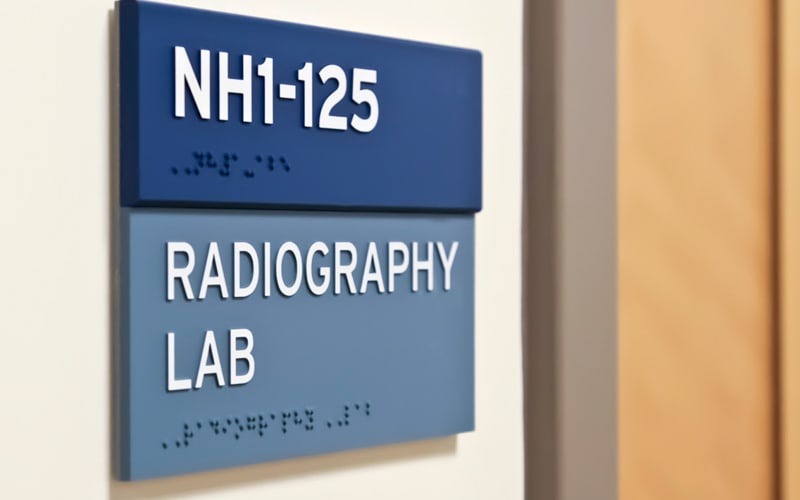Discovering the Key Attributes of ADA Signs for Boosted Availability
In the realm of access, ADA indications offer as quiet yet powerful allies, guaranteeing that rooms are comprehensive and navigable for people with impairments. By incorporating Braille and tactile aspects, these indications damage barriers for the visually impaired, while high-contrast shade systems and clear font styles provide to diverse aesthetic requirements.
Relevance of ADA Compliance
Making sure conformity with the Americans with Disabilities Act (ADA) is critical for promoting inclusivity and equivalent access in public areas and work environments. The ADA, passed in 1990, mandates that all public facilities, companies, and transportation solutions suit individuals with handicaps, ensuring they delight in the very same civil liberties and possibilities as others. Compliance with ADA requirements not just meets lawful responsibilities yet also enhances an organization's track record by showing its commitment to diversity and inclusivity.
One of the key aspects of ADA conformity is the execution of obtainable signs. ADA indications are created to guarantee that individuals with disabilities can easily browse with rooms and structures.
Furthermore, adhering to ADA laws can alleviate the danger of lawful consequences and prospective fines. Organizations that fail to follow ADA guidelines may encounter fines or legal actions, which can be both destructive and financially burdensome to their public picture. Hence, ADA conformity is essential to promoting an equitable atmosphere for every person.
Braille and Tactile Aspects
The unification of Braille and tactile components into ADA signs embodies the concepts of availability and inclusivity. These features are critical for individuals who are blind or visually damaged, enabling them to navigate public areas with greater freedom and confidence. Braille, a tactile writing system, is essential in offering created info in a style that can be easily viewed with touch. It is generally positioned underneath the matching message on signage to make sure that people can access the information without aesthetic assistance.
Responsive components prolong past Braille and consist of elevated signs and personalities. These parts are made to be noticeable by touch, enabling individuals to determine space numbers, bathrooms, departures, and other crucial locations. The ADA establishes particular standards relating to the size, spacing, and positioning of these responsive aspects to optimize readability and ensure uniformity across different atmospheres.

High-Contrast Color Pattern
High-contrast color design play a critical duty in improving the exposure and readability of ADA signs for people with visual problems. These schemes are vital as they take full advantage of the difference in light reflectance in between text and background, guaranteeing that indications are easily discernible, also from a distance. The Americans with Disabilities Act (ADA) mandates the usage of certain color contrasts to fit those with restricted vision, making it a crucial aspect of conformity.
The effectiveness of high-contrast colors lies in their capacity to attract attention in numerous illumination problems, including poorly lit settings and locations with glare. Generally, dark message on a light history or light text on a dark background is used to achieve optimal comparison. Black text on a yellow or white background gives a stark aesthetic distinction that aids in quick acknowledgment and understanding.

Legible Fonts and Text Dimension
When considering the design of ADA signage, the option of understandable fonts and appropriate text dimension can not be overemphasized. The Americans with Disabilities Act (ADA) mandates that font styles should be not italic visit this site and sans-serif, oblique, script, very attractive, or of uncommon form.
The size of the text also plays a critical role in accessibility. According to ADA standards, the minimum message elevation must be 5/8 inch, and it ought to increase proportionally with watching range. This is specifically important in public rooms where signage requirements to be read promptly and precisely. Uniformity in message size adds to a cohesive visual experience, assisting people in browsing environments successfully.
Moreover, spacing between lines and letters is important to clarity. Ample spacing stops personalities from appearing crowded, boosting readability. By sticking to these criteria, designers can significantly enhance accessibility, making sure that signs offers its intended function for all people, despite their aesthetic capacities.
Efficient Positioning Techniques
Strategic positioning of ADA signs is vital for making the most of availability and ensuring conformity with lawful criteria. Properly positioned indications lead people with impairments successfully, promoting navigating in public areas. Trick factors to consider include presence, closeness, and height. ADA guidelines stipulate that indications ought to be installed at an elevation in between 48 to 60 inches from the ground to guarantee they are within the line of view for both standing and seated people. This basic height range is essential for inclusivity, enabling wheelchair customers and people of differing elevations to gain access to details easily.
Furthermore, indicators need to be placed surrounding to the latch side of doors to permit very easy identification prior to entrance. Uniformity in indication positioning throughout a center boosts predictability, minimizing complication and improving total customer experience.

Conclusion
ADA signs play a vital duty in advertising accessibility by integrating attributes that address the requirements of individuals with impairments. click reference These components collectively promote a comprehensive environment, underscoring the significance of ADA compliance in making sure equal accessibility for all.
In the world of access, ADA indicators serve as quiet yet effective allies, ensuring that spaces are inclusive and accessible for people with impairments. The ADA, enacted in 1990, mandates that all public facilities, companies, and transportation solutions suit people with disabilities, ensuring they delight in the very same civil liberties and opportunities as others. ADA Signs. ADA indicators are developed to ensure that people with specials needs can easily navigate with areas and buildings. ADA guidelines state that indications must be mounted at an elevation in between 48 to 60 inches from the ground to ensure they are within the line of sight for both standing and seated people.ADA indicators play a crucial role in promoting accessibility by integrating functions that attend to the requirements of individuals with handicaps